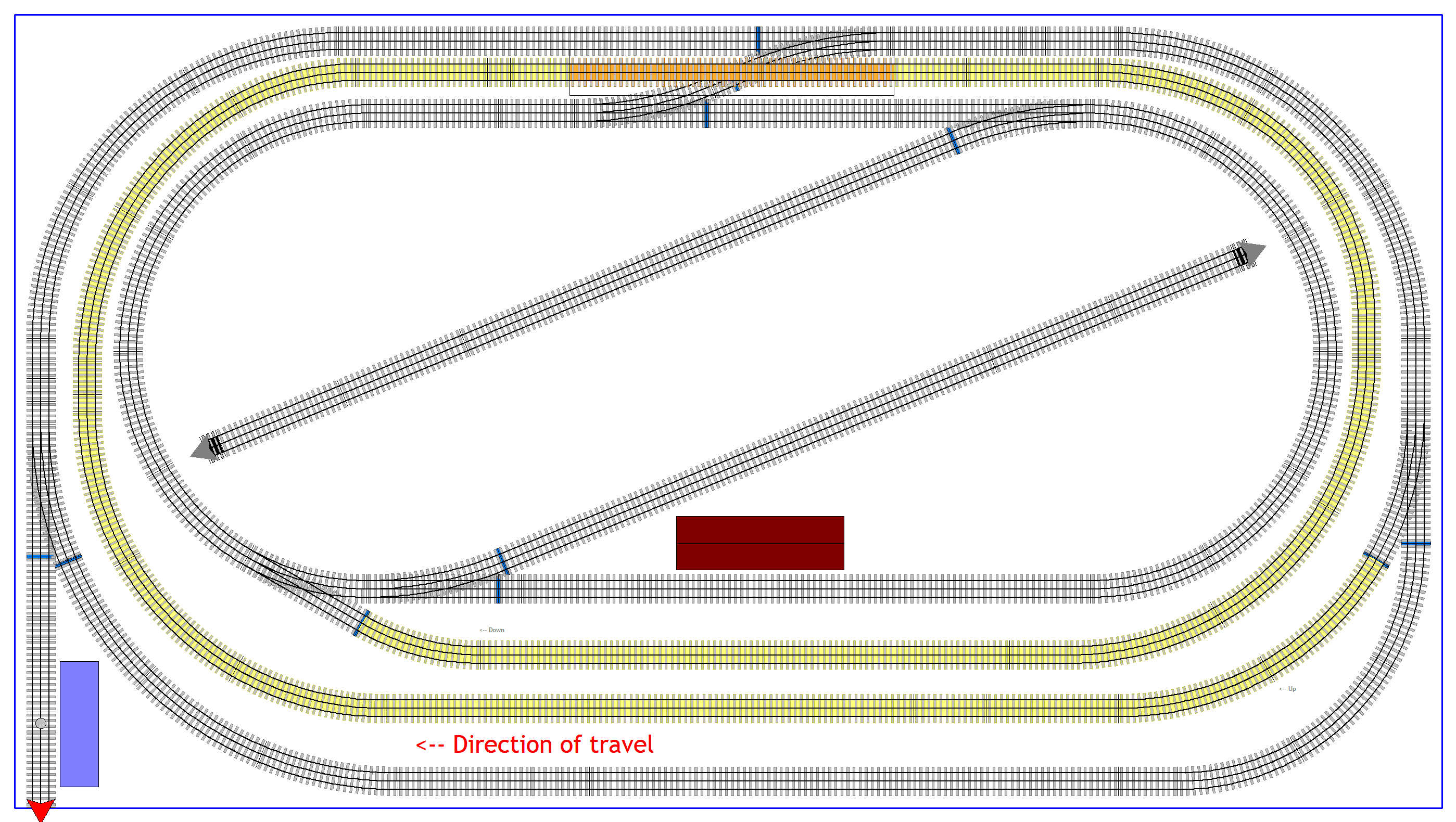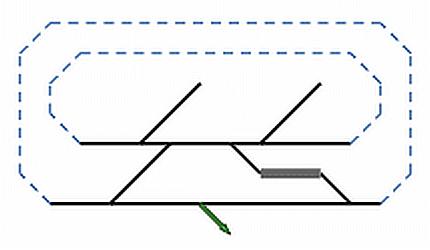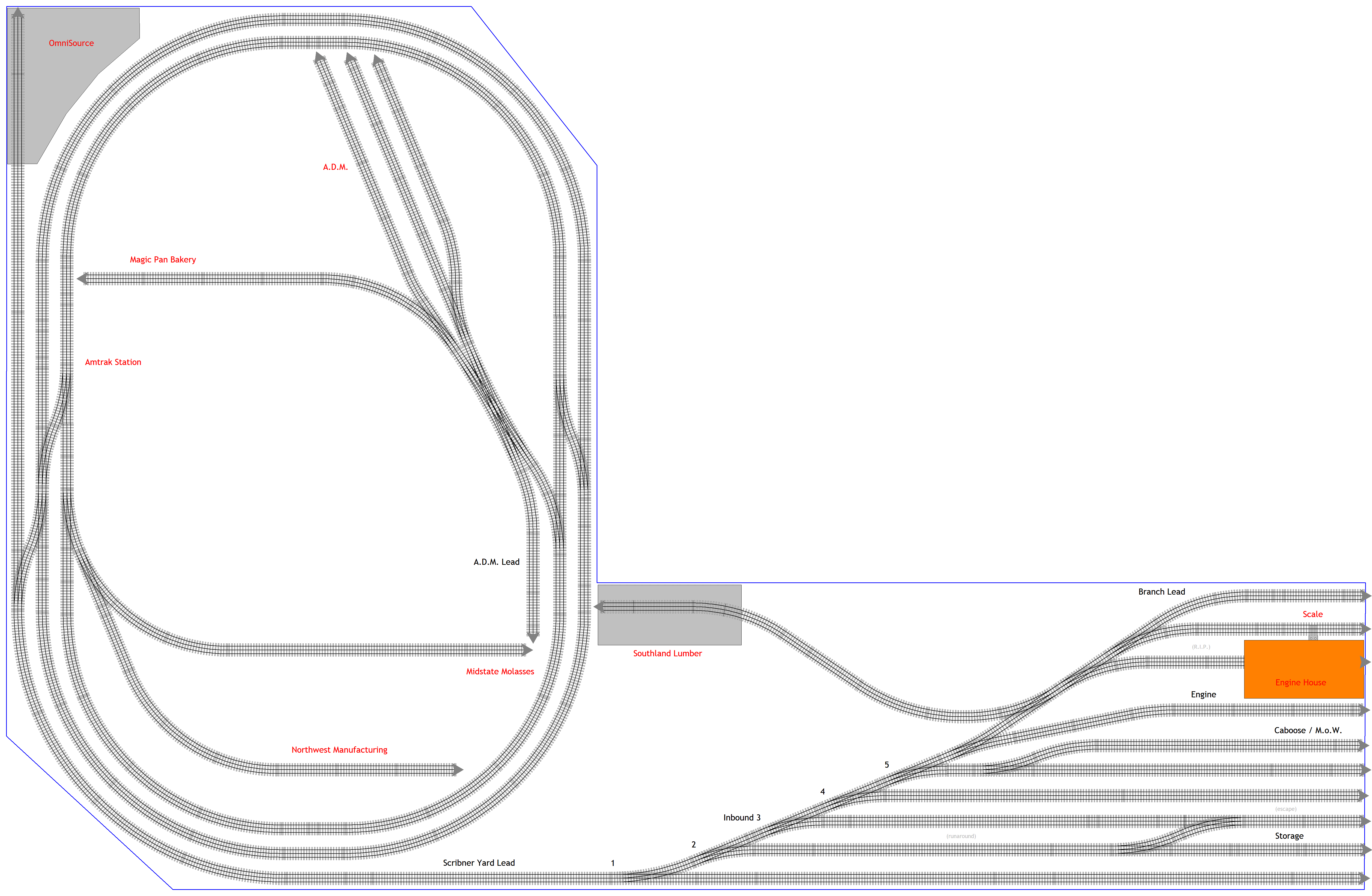If you have an eclectic collection of rollingstock, or if your visitors bring their own rollingstock, then a layout that has operational possibilities for a wide selection of rollingstock Types is desirable. The layouts drawn here continue with the goal of keeping turnout count to a minimum. Great attention was placed on fitting the track into the minimum area possible, while also for operational variety cramming in a large assortment of destinations that require differing types of cars. This meant that in most cases
The following track plan is a classic ping-pong table sized
While on the surface the plan is little more than two connected ovals on which to watch O-27 sized passenger equipment and fantasy animated cars in action (try to leave 36-42 inches of isle space around the layout for better viewing), some real railroading Operations potential has been incorporated. For example, you could spot a dining car on the short outer loop interchange spur. When the passenger train comes by, it can split its train, add the diner into the train's middle, then recombine and continue on its way.



The following track plan was conceived for "Hi-Railer" detailing. It represents a rural main line junction with minimalist station, where freights pass through and passenger trains split and join [EXPLANATION] like Amtrak's Lake Shore Limited. Although a staging-to-staging "walk in" layout, this pike is easily modified with a "duck under" to also allow continuous running. The layout is designed primarily for through freight and passenger train watching amidst a detailed non-railroad background, enhanced by gentle inside-viewed curvature, the ability to handle long
The following long shelf track plan represents a large towns passenger station, shoehorned amidst light-industries. It was imagined for a shared (storage/dryer/sofa/etc. underneath) full basement wall, but could instead be built as an integrated portable Club Module set. The left and right layout sides are bounded by roads that cross the main line at grade (passing beside the readymix plant and the commissary), where trains from staging will have to whistle. Not shown are the required staging tracks on the left side of the layout. Staging can be of any design imagined, ranging from a short single fiddle track, to a major yard on a potential continuous loop traveling back to the right side of the layout. Rather then having the staging extend onward to the left, the Readymix Plant can be the shelves end, and the Main Line could instead turn downward (so staging would be a reflection of the passenger yard).
The station is assumed to be a terminus for commuter trains heading out to the left, and merely a pause for Amtrak trains passing through. All of the destinations along the layouts front edge are realistically large, but only implied through the technique of "suggestive omission". Industries were chosen so as to provide destinations for an extremely wide range of rollingstock Types. Because the food maker only manufactures animal feed [EXAMPLE], it can be serviced by antique vat cars and wooden reefers no longer suitable for other use. Note that trains crossing the food makers private industrial track to access the Freighthouse/Express spur will need to deploy a flagman.


The following dogbone track plan is a permanent shelf layout that is simultaneously portable. While it could be permanently installed within a (now rare) mall, it was designed to fit perfectly against one of the long walls on the inside of a cargo semi-trailer (see page 12 in the book "Creative Model Railroad Design") of the type pulled by
The following island track plan is an upscaled 3rail O-scale rendition of a well designed Operations Oriented HO-scale diesel era layout. It is a careful translation of another modelers actual HO-scale model railroad [EXPLANATION], which appears to itself have been based upon Plan 19 [EXPLANATION] from "101 Track Plans for Model Railroaders". The tall business district buildings and subtle grades [ESSAY] effectively act as view blocks to obscure the big ovals, which makes the layout appear even larger. The outer oval allows railfanning a continuously orbiting train, while not interfering with industry switching. Although primarily a freight layout, the Amtrak station accommodates visits by a through Amtrak and/or regional passenger train.
Being a layout that "grows", you can first build the 8' x 12' (e.g. exactly three plywood sheets) double oval island in three expanding stages. Although the baseboard is large (leaving lots of room for scenery), the tracks are easily reachable. If desired later as time, finances, and skills increase, you can add the optional Scribner Yard peninsula (along with the yard lead, OmniSource scrap dealer, and connecting turnout on a narrow strip of extension to the island) as the massive fourth stage. The engine house with its overhead crane also serves as a R.I.P. track. Whenever possible, leave yard tracks 2 and 3 clear as a runaround (the ovals function as the runaround on the island). Small license was taken in shifting downward the outer oval turnout to the yard lead, converting the branch lead to a Track Scale, repurposing the caboose track as the branch lead (note that this lead offers a good location to fiddle a car on/off the layout), and now using yard track six as the caboose/M.o.W track.



Suggestion: The lead to OmniSource would make a suitable location to park (e.g., visibly stage) a passenger train until it needs to travel to the station.
All content appearing on this webpage is FREE for personal use,
being either expressly created or previously posted as anonymously accessible public on the Internet.
No - Signups, Carts, Tracking, Cookies, or JavaScript